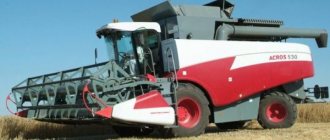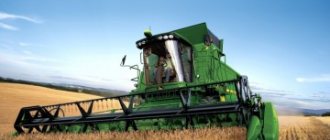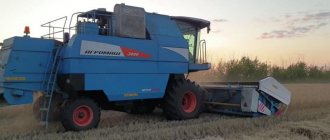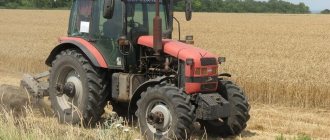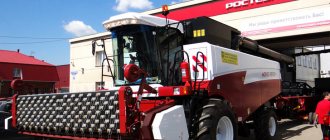Combine New Holland 6090
This efficient and dynamic harvester offers the following features :
- motor FPT Cursor 9 for 299hp and 8.7 l;
- three-speed hydrostatic transmission;
- fuel tank - 580l;
- fuel consumption - 6-8 l / ha;
- computer-controlled final threshing system;
- the volume of the bunker for grain - 9300l;
- rotary separator.
Model advantages:
- Increasing yield and quality with innovative separation and threshing on four drums in series;
- Fast adjustment through calibrations due to changes in yield, maturity and degree of crop moisture;
- Possibility to harvest both rapeseed and grain on a single header;
- Efficient even on uneven fields thanks to the Autofloat option.
This combine will be a worthy choice for agricultural enterprises and, compared with analogues, it gives an increase of 20% in harvesting.
Advantages of combines New Holland (New Holland)
Common to all New Holland models is concern for the convenience of management and work on a combine of any brand. An excellent overview, automated control systems for the operation of the combine as a whole and its individual units, allow you to feel comfortable in any weather conditions. This has a positive effect on the productivity of grain harvesters. The technical characteristics of New Holland combines meet the most modern standards.
The reliability and efficiency of New Holland combine harvesters is evidenced by the fact that the price of the New Holland combine in the secondary market is quite high compared to some new models from other manufacturers.
Wheat Fields Dream - New Holland Combine
How did it all start?
Abe Zimmerman did not imagine that his small farm equipment repair shop would turn into a branched powerful New Holland Machine Company in 8 years.
The year was 1895, and Zimmerman did not have efficient equipment and tools even for repairs, let alone building a new car.
But in 1956, the M73 machine was presented to the admiring glance of the farmers of the world.
The rough outlines of the self-propelled unit still inspired confidence: the car was equipped with an 80 hp Ford engine. s., despite the fact that the merger of New Holland and Ford took place only in 1986.
Why New Holland? That was the name of the small town in which Zimmermann's workshop was located.
He not only elevated this name to the “name” of a world-class concern, but also demonstrated what the best combine should be.
Today
From the 60s. New Holland is a developed company with colossal volumes of production and production of combine harvesters. The classic design of machines of this type has a dozen modifications.
As a result, each model range embodies the wishes of a particular farmer with the areas of his land, soil and plant characteristics, climatic conditions and other nuances.
In 1975, the innovative Twin Rotor technology was introduced into the layout of the combines, which caused a gasp of astonishment from users and competitors. In modern "hollands" she still occupies a place of honor.
Why so many developments? The company managed to find new ways to finance them by teaming up with more profitable plants. In 1999, New Holland became part of the global concern CNH.
But the author's technological "highlights" were not lost in a huge "cupcake" of dozens of powerful companies. On the contrary, with access to new opportunities, the company has strengthened its position in the market.
Regardless of the economic situation, harvesters have been and will continue to be sold.
It is not easy to navigate in a variety of series and models. The average cost of a combine is about 75 thousand dollars.
Many entrepreneurs will want to invest that amount in a machine with a certain set of features without overpaying for technological frills.
It is impossible to give a complete description of New Holland combines without analyzing their series and model ranges.
Each of them embodied new achievements that illustrate the advantages and features of machines from different periods of the company's activity. So there are many episodes.
TC 5000 Series – Clear and Clear
A small farm is a compact machine. The series was founded in 1991, when the New Holland Clayson combines were discontinued.
A decisive leap into the future was marked by a rotary separator, which increased the grain separation area: it is 6.27 square meters. m.
Efficient threshing and separation are provided by an improved drum design with an increased concave angle. With such a bevel width, grass plugs are sometimes formed, the presence of which was provided for by the engineers.
It is enough to press the header reverse pedal and the feeder house conveyor, then the machine will respond to the command.
Harvesting in hilly terrain does not lead to grain losses if there is an automatic leveling of the upper sieve sections, which is included in the package of combines of this series.
Later, this technology developed into the Lateralfloat system in the New Holland TC 5070 and 5080 combine models.
Even crops that are difficult to thresh will not resist a powerful beater. The performance of the separator does not decrease in the rain: it separates grain from wet straw with the same efficiency.
Until 2000, they were produced with a mechanical transmission, which was replaced by a hydrostatic one on some models.
Series CX 5000, 6000, 7000, 8000 – a hymn to versatility
We can talk about the tangible progress of new technological solutions embodied in New Holland combines.
By the end of the last century, the company has established itself in the agricultural equipment market as a legendary manufacturer of ergonomic machines of high quality assembly.
Excellent representatives of these series are New Holland TS 6090, 7080 and 8080 combines.
In 2001, the public was delighted with the new brainchild - a combine with a 2-drum threshing system. The drum diameter was 75 cm, the volume of the bunker was increased to 10.5 tons.
With improved characteristics, the size of the combine remained the same. This "ship of the desert" with a cabin towering above the drum has not lost its maneuverability.
Models of the CX series are equipped with five- and six-key straw walkers, Iveco engines and a system of uniform distribution of grain on the Smart Sieve sieve.
A distinctive feature of the machines is the victory over the main negative effect of the combine - grain damage. In addition, this effect is associated with the performance of threshing and cleaning functions.
Poorly adjusted cleaning inevitably leads to grain getting through the return auger again for threshing. In the New Holland technique, this is excluded.
Precise adjustment, gentle threshing and other technological achievements have increased the productivity of the machines by 15% compared to previous models.
Successful design provides for the use of a wide range of attachments - headers and mowers of various modifications.
Harvesting corn and wheat has become convenient and fast due to the increased size of the header.
CR Series: From fields to records
However, it was not the representatives of the CX series that were destined to become champions in economical grain harvesting.
In 2013, the CR entered the Guinness Book of Records as the most efficient harvester. In 2008, he was recorded as a record holder in terms of productivity.
The design, features and options of the machines are by no means a compilation of previous achievements. This is novelty in all its manifestations.
The twin-rotor threshing system is the only feature previously known.
Combines New Holland CR 9060, 9080, 9090 with an enlarged sieve amaze with the speed and quality of cleaning. The sieve gap is adjusted by the operator using a remote control panel.
It is not for nothing that the cabin seems to hover above the external working units of the machine: the idea made room for the bunker and provided easy control of operational parameters directly from the cabin.
The header control system includes a laser scan that distinguishes between cut and uncut stems. Based on the data received, the machine automatically “adjusts” to the expected amount of work:
- the optimal speed is selected;
- cutting intensity is selected.
A set of headers reveals the functionality of the combine. Mowing and harvesting fodder crops do not require special technical equipment.
Model range of combine harvesters New Holland
Combines are produced for different operating conditions. Initially, it was decided to create the same type of machine with different performance. This has determined the lineup that manufacturers are trying to stick to.
| Main characteristics | Model ranges of combines New Holland | |||
| TC 5000 Series Combines | CX 6000 and 8000 Series Combines | CSX 7000 Series Combines | CR 9000 Series Combines | |
| Purpose of the lineup | Harvesting small fields with complex geometry | Universal combine that allows the installation of different equipment | Combines of medium productivity, designed for fields up to 1500 ha | Combines for large fields with high yields, seasonal production of more than 2500 ha |
| Engine power, h.p. | 240 | 300 | 330 | 460 |
| Grain tank volume, l | 6000 | 9300 and 10500 | 9000 | 11500 |
In Europe, two series of New Holland CX 6000 (8000) and CSX 7000 combines are produced. The explanation is quite simple. The first model range is designed for harvesting all types of crops, and the second is a relatively small and easy-to-work agricultural machine. Russia does not directly purchase agricultural machinery from this company. But there are still offers to sell. The main importers are several Eastern European countries. It is from there that offers for the sale of New Holland combines to the Russian market come.
| Importer countries of grain harvesting equipment New Holland | Data by years | |||
| 2012 | 2013 | 2014 | 2015 | |
| Bulgaria, piece | 52 | 84 | 86 | 112 |
| Hungary, pcs. | 38 | 66 | 54 | 62 |
| Slovakia, piece | 23 | 38 | 22 | 30 |
| Romania, piece | 11 | 6 | 12 | 8 |
| Ukraine, piece | – | 10 | 18 | 12 |
| Belarus, piece | – | – | 5 | 7 |
It can be seen that the demand for these machines in Eastern Europe is small. They began to be acquired in Belarus and Ukraine quite recently. Judging by the advertisements for the sale, only used agricultural machines are sold in the CIS countries. Even their residual price is solid, in terms of the Russian ruble, the average price is at the level of 3.0 ... 3.5 million rubles. But sales are limited, buyers are confused by the lack of a repair base and after-sales service on the territory of the Russian Federation. Construction equipment dealers from New Holland are in no hurry to commit themselves to supplying spare parts for agricultural equipment.
Tip #1: Should You Buy a New Holland Combine? Currently, there is no need to hurry with the purchase of such machines. There is no guarantee that spare parts will be delivered on time.
Forage harvesters from New Holland
Forage harvesters are represented by the FR series. These are compact machines, they have comparatively grain bins. Some harvest only on the green mass, without separating the grain from the rest of the plant.
Forage harvester New Holland FR series. The purpose of such a harvester is to harvest corn. The width of this header is only 3.8 m
Model range in this series by digital codes. There are no special differences from 400 to 700 series. Only the power of the engine changes. On 600 and 700 series models, you can install a grain header and harvest grain. But this feature is rarely used.
Attachments for forage harvesters allow you to harvest:
- corn for grain and green mass; when harvesting, non-green mass is attached to a trolley, which is transported by a forage harvester;
- rapeseed is harvested for seeds, a thresher is opened and fine-mesh decks are installed;
- seeds of perennial grasses are harvested using headers with a working width of 3 m.
This series of cars is interesting. The prospects for their use on the territory of the Russian Federation have not yet been determined. The domestic industry has long and successfully produced analogues of forage harvesting equipment. Therefore, the demand for New Holland is almost zero.
